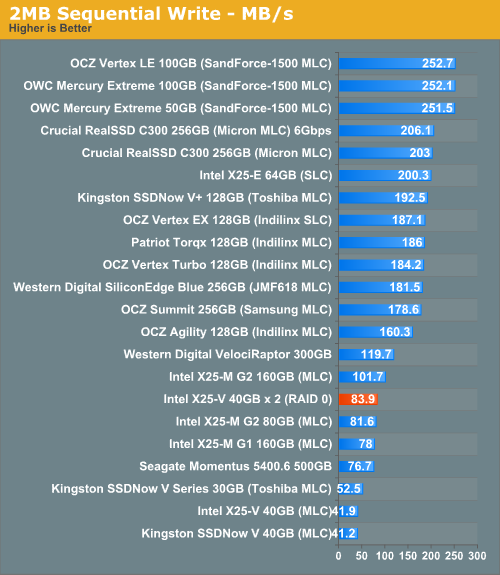Intel X25-V in RAID-0: Faster than X25-M G2 for $250?
by Anand Lal Shimpi on March 29, 2010 8:59 PM ESTSequential Read/Write Speed
Using the 6-22-2008 build of Iometer I ran a 3 minute long 2MB sequential test over the entire span of the drive. The results reported are in average MB/s over the entire test length:

This starts out very interesting. Each SATA port on our X58 board is bound by a 3Gbps transfer limit, but run two in parallel and you can go much higher. Our pair of X25-Vs are actually faster than Crucial's RealSSD C300 on a 6Gbps controller! That's absolutely nuts.

Sequential write speed also shows a near doubling of performance, unfortunately that only brings us up to ~84MB/s. It's not bad for most users but if you do a lot of heavy downloading or file copying, you'll still be behind an Indilinx, Crucial or SandForce drive.










87 Comments
View All Comments
morphin1 - Saturday, April 3, 2010 - link
Thank you a lot Anand for the reply and clearing that up for me.The Sony Vaio Z has samsung MMCRE28G drives(2*64GB).
I am holding my buying decision on your recomendation. What say you? Will the above drives be rendered useless overtime with Trim?
Thanks you a lot for your time.
I have been reading AT for over 2years now and love the indepth reviews you guys do as opposed to other sites.
Love this site.
Cheers
morphin1 - Saturday, April 3, 2010 - link
How will the samsung drive fare without TRIM.I wrote incorrectly when i said With TRIM.
Chloiber - Sunday, April 4, 2010 - link
What's the QD of the random read/write tests (did I miss it?)?AnalyticalGuy3 - Wednesday, April 7, 2010 - link
Suppose I have four X25V's in RAID 0 using the Intel ICH10. Two questions:
1) Just to confirm my understanding, a random read request smaller than the stripe size should only access one member of the array, correct?
2) Suppose the queue contains four random read requests smaller than the stripe size. And suppose I'm really lucky -- each random read request happens to tap a different member of the array. Is the ICH10 smart enough to dispatch all four random read requests in parallel?
boostcraver - Tuesday, April 13, 2010 - link
Anand,I'm sure I read this article thoroughly but I didn't see exactly what the RAID configuration was - whether onboard raid, dynamic disks in Windows, or a dedicated RAID add-in card.
Once that is explained, it'd be great if we could get a benchmark comparison of these different RAID technologies. Something to justify the simplicity of using Windows dynamic disks for raid0 / raid1 configuration, or to spend the extra bucks on a SAS/SATA raid card. Since everyone has been supporting RAID0 for the best performance, we should understand exactly the options at hand.
Thanks for the great articles.
- boostcraver
Shin0chan - Friday, June 18, 2010 - link
"A standard 80GB X25-M wouldn't be this bad off, the X25-V gets extra penalized by having such a limited capacity to begin with. You can see that the drive is attempting to write at full speed but gets brought down to nearly 0MB/s as it has to constantly clean dirty blocks. Constant TRIMing would never let the drive get into this state. It's worth mentioning that a desktop usage pattern shouldn't get this happen either. Another set of sequential writes will clean up most of this though"Hi guys, I understood where this topic was going until I read the last sentence of this paragraph and this lost me. I'm trying to understand this from a normal day-to-day usage train of thought; the performance degradation is mind blowing.
So how would I do a bunch of sequential writes to the drive if my OS and Apps would be sitting on this? (They normally take up about 60-65GB for me.) From my understanding, this means I would have to use Secure Erase and restore from say a complete backup.
Please enlighten me lol. Thanks.
chaosfox97 - Tuesday, August 3, 2010 - link
If it got over loaded and you were regretting putting it into RAID-0, couldn't you just change it to normal, use TRIM, and change it back to RAID-0?